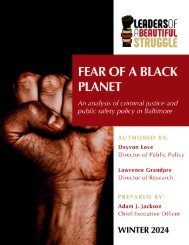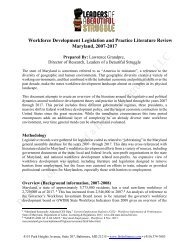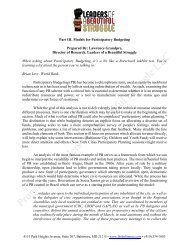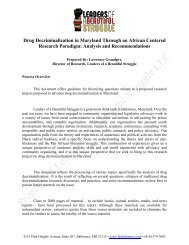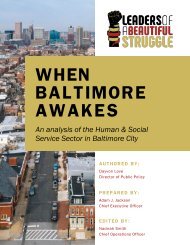The Communal Impacts of Drug Criminalization in Maryland
This project attempts to reframe the harms of drug criminalization. Influenced by African-Centered Research Methodologies, we engaged in a literature review and qualitative research of the communal impacts of drug decriminalization in Maryland, with a specific focus on Baltimore.
This project attempts to reframe the harms of drug criminalization. Influenced by African-Centered Research Methodologies, we engaged in a literature review and qualitative research of the communal impacts of drug decriminalization in Maryland, with a specific focus on Baltimore.
Create successful ePaper yourself
Turn your PDF publications into a flip-book with our unique Google optimized e-Paper software.
Dis<strong>in</strong>vestment <strong>in</strong> Black communities has left the drug trade as a major means <strong>of</strong> economic empowerment.<br />
This was understood <strong>in</strong> the context <strong>of</strong> the mass <strong>in</strong>carceration <strong>of</strong> Black people due to drug crim<strong>in</strong>alization.<br />
Systems <strong>of</strong> White supremacy and their negative impacts on Black civil society can be connected to why<br />
communities turn to the drug trade for economic opportunities and how the violence and mass<br />
<strong>in</strong>carceration from drug crim<strong>in</strong>alization policies are used to further dismantle the social, economic and<br />
political power <strong>in</strong> these same communities.<br />
As one <strong>in</strong>terviewee put it:<br />
“If one goes with the social control perspective and social control is racialized, then that's racial<br />
control. What is the best way to control people? To convict them, lock them up. It is a vicious<br />
cycle <strong>of</strong> be<strong>in</strong>g <strong>in</strong> prison, com<strong>in</strong>g out without provid<strong>in</strong>g a lot <strong>of</strong> opportunities which places the<br />
person at further risk. For what? Go<strong>in</strong>g back, a vicious cycle <strong>of</strong> <strong>in</strong>carceration.” (Jay)<br />
<strong>The</strong> Pressures <strong>of</strong> the Prison Industrial Complex:<br />
Incarceration and Police Brutality<br />
Build<strong>in</strong>g prisons and keep<strong>in</strong>g them filled <strong>in</strong> order to make more money contributes to community harm.<br />
An <strong>in</strong>terviewee who worked <strong>in</strong> the crim<strong>in</strong>al justice system provided <strong>in</strong>sight <strong>in</strong>to the economic model <strong>of</strong><br />
prison systems <strong>in</strong> Baltimore, stat<strong>in</strong>g:<br />
I was once <strong>in</strong> an executive meet<strong>in</strong>g that was about all the money that was be<strong>in</strong>g put <strong>in</strong> a new<br />
prison to be built. One <strong>of</strong> the th<strong>in</strong>gs that was said, well if we keep build<strong>in</strong>g, they’ll keep com<strong>in</strong>g.<br />
If your perspective is that you should build more prisons because you'll fill them, then I th<strong>in</strong>k<br />
you’re <strong>in</strong> the wrong l<strong>in</strong>e <strong>of</strong> work, and you're a part <strong>of</strong> the problem. You're not the solution. So,<br />
it's the whole th<strong>in</strong>k<strong>in</strong>g that’s there, and it's real because it is an opportunity down to the toilet<br />
paper that is sold <strong>in</strong> a prison system, this is a big money maker.” (Tabatha)<br />
Police surveillance and brutality was also a recurr<strong>in</strong>g theme among participants when discuss<strong>in</strong>g<br />
community harm from drug crim<strong>in</strong>alization. One <strong>in</strong>terviewee expressed their concern that police are<br />
typically the answer to issues that arise <strong>in</strong> Black communities, which creates apprehension around a sole<br />
approach to decrim<strong>in</strong>alization. One <strong>in</strong>terviewee recounted:<br />
“In Sandtown, the boys were talk<strong>in</strong>g about the police be<strong>in</strong>g just another gang because they’d<br />
jump our boys! In an unmarked car they'd come <strong>in</strong>to the community, <strong>in</strong>to the neighborhood and<br />
jump out and just start knock<strong>in</strong>g people around and push<strong>in</strong>g people around and, accus<strong>in</strong>g<br />
people <strong>of</strong> th<strong>in</strong>gs. And the children experienced this. How can they go to the police with<br />
anyth<strong>in</strong>g when the police could not be trusted? [emphasis added] And they knew that<br />
the police were bust<strong>in</strong>g people and tak<strong>in</strong>g their drugs and not report<strong>in</strong>g. You know the kid, the<br />
corner boy would have to give up his stash and the police would leave him alone. Well, what<br />
was this k<strong>in</strong>d <strong>of</strong> th<strong>in</strong>g? So, we're here talk<strong>in</strong>g to these children about try<strong>in</strong>g to do the right th<strong>in</strong>g<br />
and obey the law and all that and then they say well, look at the people who are do<strong>in</strong>g the law,<br />
the contradiction there!” (Olusola)<br />
<strong>The</strong> use <strong>of</strong> drugs to unjustly target Black people is a tactic that has been used for decades <strong>in</strong> the U.S. and is<br />
still be<strong>in</strong>g done to this day <strong>in</strong> Baltimore. Increased surveillance <strong>in</strong> predom<strong>in</strong>antly Black neighborhoods<br />
where drug treatment centers are also usually located also created barriers to access<strong>in</strong>g services. One<br />
<strong>in</strong>terviewee recounted:<br />
“A lot <strong>of</strong> time the police post up there [at drug addiction centers], assum<strong>in</strong>g that these people<br />
who are struggl<strong>in</strong>g with addiction gotta be <strong>in</strong>to some crim<strong>in</strong>al activities. If I’m try<strong>in</strong>g to get<br />
help, I have to deal with that. Be on display.” (Rashard)<br />
Community members experienced unsolicited violence from the police and saw police <strong>of</strong>ficers break<strong>in</strong>g<br />
the law which led to a lack <strong>of</strong> trust and fear. One harm reduction advocate work<strong>in</strong>g <strong>in</strong> policy advocacy and<br />
community organiz<strong>in</strong>g mentioned:<br />
27 <strong>of</strong> 55




